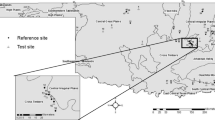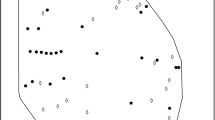Abstract
Floristic Quality Assessment requires compiling a full list of vascular plant species for the wetland. Practitioners may lack the time and taxonomic skills for full-community vegetation surveys, especially when wetlands are large and complex. In this paper we broadly ask whether floristic quality indicator species may exist for wetlands, specifically evaluating indicator species potential for high floristic quality depressional wetlands in the US southern plains. Candidate indicators were identified for a broader context (depressions across Oklahoma prairie ecoregions) and narrower context (depressions in the northern Central Great Plains of Oklahoma) and evaluated based on performance, validity, and robustness criteria. Nine individual species and two species pairs showed exclusivity and ubiquity for high floristic quality, with their value generally improving in the narrower context. However, the overall best indicator (Eleocharis compressa) frequently occurred (> 20 % rate) in lower quality validation sites, and all indicators were lacking in one or more criteria. Combining E. compressa with select other candidates (Ammannia coccinea, Juncus torreyi, Leersia oryzoides) may compensate for weaknesses of individual species but the combinations may rarely be found across the region, suggesting they may not be useful in practice or that high-quality conditions are in fact scarce. Overall, these results offer mixed support for relying on indicator species to rapidly identify or verify high floristic quality depressional wetlands in the US southern plains. We recommend similar studies with larger datasets in other regions and testing other quality levels (low, moderate) before broadly concluding whether floristic quality indicator species may exist for wetlands.




Similar content being viewed by others
Data Availability
Available from the corresponding author upon request.
Code Availability
Available from the corresponding author upon request.
References
Bachand M, Pellerin S, Côté SD, Moretti M, De Cáceres M, Brousseau PM, Cloutier C, Hébert C, Cardinal É, Martin JL, Poulin M (2014) Species indicators of ecosystem recovery after reducing large herbivore density: comparing taxa and testing species combinations. Ecological Indicators 38:12–19
Bried JT, Jog SK, Dzialowski AR, Davis CA (2014) Potential vegetation criteria for identifying reference-quality wetlands in the southcentral United States. Wetlands 34:1159–1169
Bried JT, Jog SK, Davis CA, Dzialowski AR (2016) Rapid buffer assessment fails to predict and classify wetland floristic quality in Oklahoma. Wetlands 36:799–805
Bried JT, Allen BE, Azeria ET, Crisfield VE, Wilson MJ (2018) Experts and models can agree on species sensitivity values for conservation assessments. Biology Conservation 225:222–228
Bried JT, Fouts TS, Jog SK (2019) Enhanced indicator species performance with increasing contextualization. Conservation Science Practice 1(12):e127
Brooks RP, Wardrop DH, Cole CA (2006) Inventorying and monitoring wetland condition and restoration potential on a watershed basis with examples from spring creek watershed, Pennsylvania, USA. Environmental Management 38:673–687
Brooks RP, Faber-Langendoen D, Serenbetz G, Rocchio J, Stein ED, Waltz K (2016) Towards creating a national Reference Wetlands Registry. National Wetlands Newsletter 38(3):7–11
Chamberlain SJ, Brooks RP (2016) Testing a rapid Floristic Quality Index on headwater wetlands in central Pennsylvania, USA. Ecological Indicators 60:1142–1149
De Cáceres M, Legendre P (2009) Associations between species and groups of sites: indices and statistical inference. Ecology 90:3566–3574
De Cáceres M, Legendre P, Wiser SK, Brotons L (2012) Using species combinations in indicator value analyses. Methods in Ecology and Evolution 3:973–982
DeBerry DA, Chamberlain SJ, Matthews JW (2015) Trends in floristic quality assessment for wetland evaluation. Wetland Science Practice 32(2):12–22
Drew LW (2011) Are we losing the science of taxonomy? As need grows, numbers and training are failing to keep up. BioScience 61:942–946
Dufrêne M, Legendre P (1997) Species assemblages and indicator species: the need for a flexible asymmetric approach. Ecological Monographs 67:345–366
Dvorett D, Bidwell J, Davis C, DuBois C (2012) Developing a hydrogeomorphic wetland inventory: reclassifying National Wetlands Inventory polygons in Geographic Information Systems. Wetlands 32:83–93
Ewing AK, Hoagland B (2012) Development of floristic quality index approaches for wetland plant communities of Oklahoma. Final report to US Environmental Protection Agency Region 6 and Oklahoma Conservation Commission, FY 2010, 104(b)(3), CD-00F074
Ficken CD, Rooney RC (2020) Linking plant conservatism scores to plant functional traits. Ecological Indicators 115:106376
Gallaway S, Davis C, Dvorett D, Tramell B (2019) Evaluating the effectiveness of Floristic Quality Assessment as a tool for determining the condition of depressional wetlands across ecoregions. Ecological Indicators 95:502–508
Herlihy AT, Kentula ME, Magee TK, Lomnicky GA, Nahlik AM, Serenbetz G (2019) Striving for consistency in the National Wetland Condition Assessment: developing a reference condition approach for assessing wetlands at a continental scale. Environmental Monitoring and Assessment 191(Suppl 1):327
Hoagland B (2000) The vegetation of Oklahoma: a classification for landscape mapping and conservation planning. Southwestern Naturalist 45:385–420
Hoagland B (2002) A classification and analysis of emergent wetland vegetation in western Oklahoma. Proceedings of the Oklahoma Academy of Sciences 82:5–14
Host GE, Schuldt J, Ciborowski JJH, Johnson LB, Hollenhorst T, Richards C (2005) Use of GIS and remotely sensed data for a priori identification of reference areas for Great Lakes coastal ecosystems. International Journal of Remote Sensing 26:5325–5342
Kentula ME, Paulsen SG (2019) The 2011 National Wetland Condition Assessment: overview and an invitation. Environmental Monitoring and Assessment 191(Suppl 1):325
Kutcher TE, Forrester GE (2018) Evaluating how variants of floristic quality assessment indicate wetland condition. Journal of Environmental Management 217:231–239
Magee TK, Blocksom KA, Fennessy MS (2019) A national-scale vegetation multimetric index (VMMI) as an indicator of wetland condition across the conterminous United States. Environmental Monitoring and Assessment 191(Suppl 1):322
Matthews JW, Endress AG (2008) Performance criteria, compliance success, and vegetation development in compensatory mitigation wetlands. Environmental Management 41:130–141
Noss RF (1996) The naturalists are dying off. Conservation Biology 10:1–3
Omernik JM, Griffith GE (2014) Ecoregions of the conterminous United States: evolution of a hierarchical spatial framework. Environmental Management 54:1249–1266
Siddig AAH, Ellison AM, Ochs A, Villar-Leeman, Lau MK (2016) How do ecologists select and use indicator species to monitor ecological change? Insights from 14 years of publication in Ecological Indicators Ecological Indicators 60:223–230
Sólymos P, Azeria ET (2018) opticut: Likelihood based optimal partitioning and indicator species analysis. R package Version 0.1-2. https://github.com/psolymos/opticut
Spyreas G (2019) Floristic Quality Assessment: a critique, a defense, and a primer. Ecosphere 10(8):e02825
Stapanian MA, Adams JV, Gara B (2013) Presence of indicator plant species as a predictor of wetland vegetation integrity: a statistical approach. Plant Ecology 214:291–302
Taft JB, Wilhelm GS, Ladd DM, Masters LA (1997) Floristic quality assessment for vegetation in Illinois: a method for assessing vegetation integrity. Erigenia 15:3–95
Tyrl JR, Bidwell TG, Masters R, Elmore RD, Weir J (2007) Oklahoma’s native vegetation types. Oklahoma Cooperative Extension Service Publication No. E-993
USEPA [U.S. Environmental Protection Agency] (2002) Methods for evaluating wetland condition: Using vegetation to assess environmental conditions in wetlands. Office of Water, U.S. Environmental Protection Agency, Washington, DC (EPA-822-R-02-020)
USACE [U.S. Army Corps of Engineers] (2010) Regional supplement to the Corps of Engineers wetland delineation manual: Great Plains Region (Version 2.0). U.S. Army Corps of Engineers, Engineer Research and Development Center, Environmental Laboratory ERDC/EL TR-10-1
USEPA [U.S. Environmental Protection Agency] (2011) National Wetland Condition Assessment: USA-RAM Manual. U.S. Environmental Protection Agency, Washington, DC (EPA-843-R12-001)
Acknowledgements
We thank Josh Crane and Jana Green for assisting with vegetation surveys. The 2012–2015 data collection was supported by U.S. Environmental Protection Agency (EPA) Wetland Program Development Grants awarded through Oklahoma State University; 2016 by the Oklahoma Conservation Commission and EPA National Wetland Condition Assessment; and 2017–2018 by the Department of Natural Sciences at Northeastern State University. We also thank an anonymous reviewer who offered many excellent ideas and suggestions to improve the manuscript.
Funding
Please see the Acknowledgments section.
Author information
Authors and Affiliations
Contributions
JTB and SKJ conceived the study idea. JTB designed the study. All authors collected the data. TSF and JTB performed the analysis. JTB wrote the manuscript with reading, input, and approval from TSF and SKJ.
Corresponding author
Ethics declarations
To the best of our knowledge this study was conducted in compliance with all relevant ethical and legal standards, and all necessary permissions (to access field sites, to collect and use data) were obtained.
Conflicts of Interest/Competing interests
Not applicable.
Ethics Approval
Not applicable.
Consent to Participate
Not applicable.
Additional information
Publisher’s Note
Springer Nature remains neutral with regard to jurisdictional claims in published maps and institutional affiliations.
This article belongs to the Topical Collection: Applied Wetland Science.
Supplementary Information
ESM 1
(DOCX 26.3 KB)
Rights and permissions
About this article
Cite this article
Bried, J.T., Fouts, T.S. & Jog, S.K. Searching for Indicator Species of High Floristic Quality Depressional Wetlands in the US Southern Plains. Wetlands 41, 96 (2021). https://doi.org/10.1007/s13157-021-01492-9
Received:
Accepted:
Published:
DOI: https://doi.org/10.1007/s13157-021-01492-9




